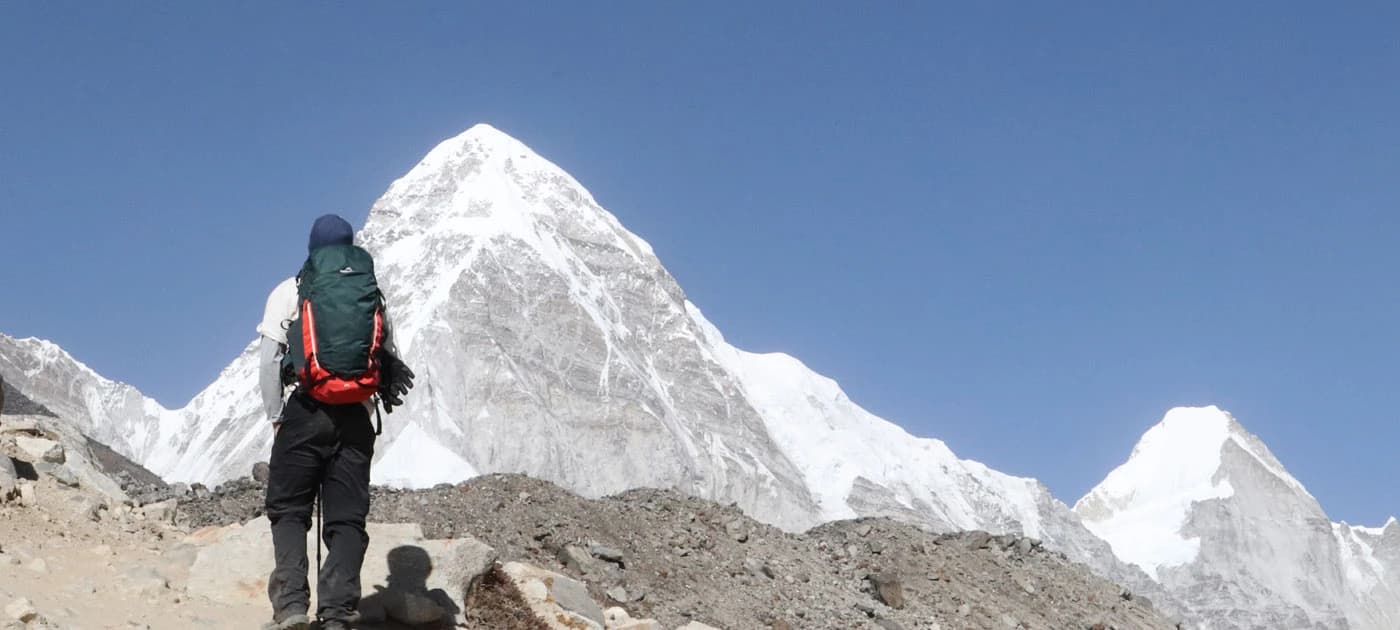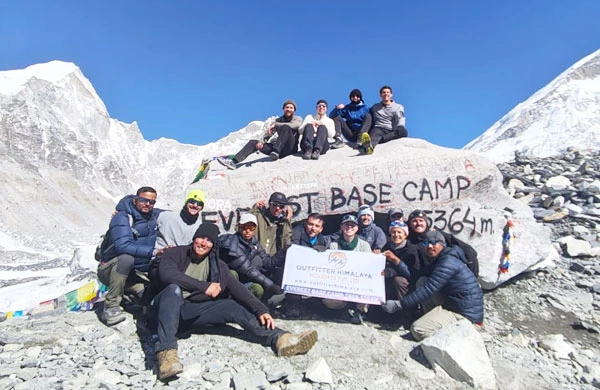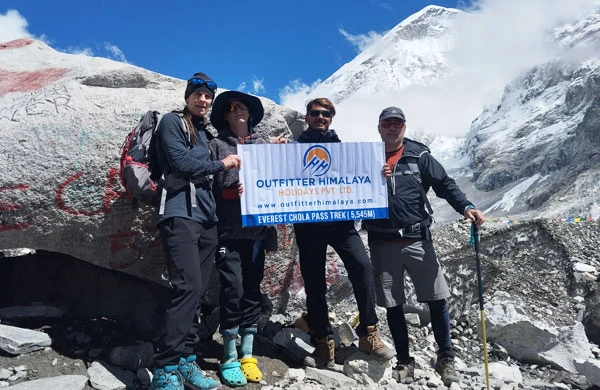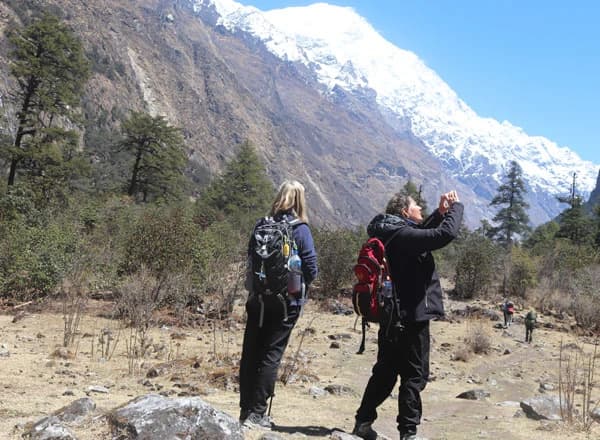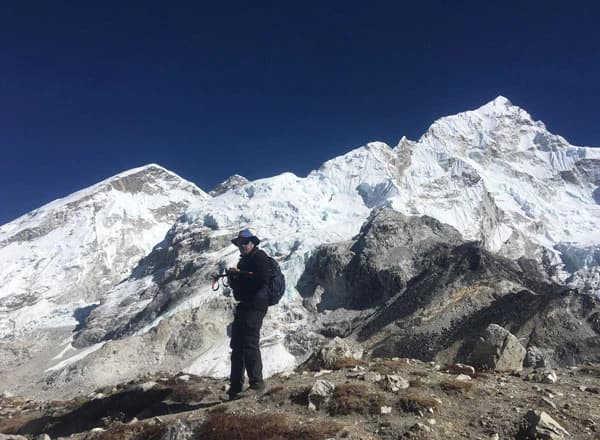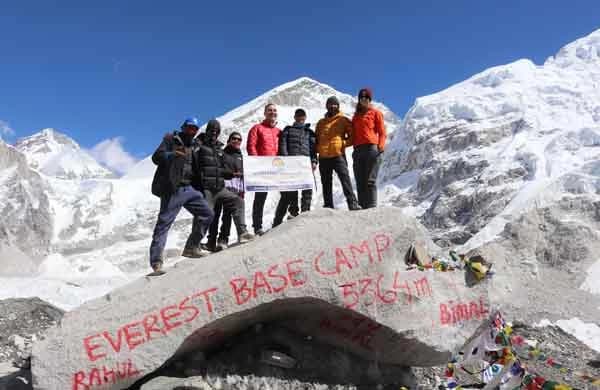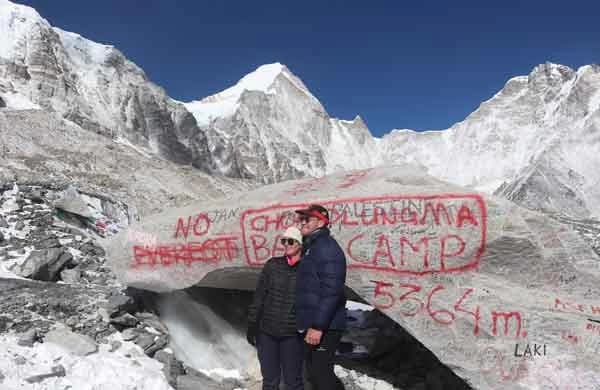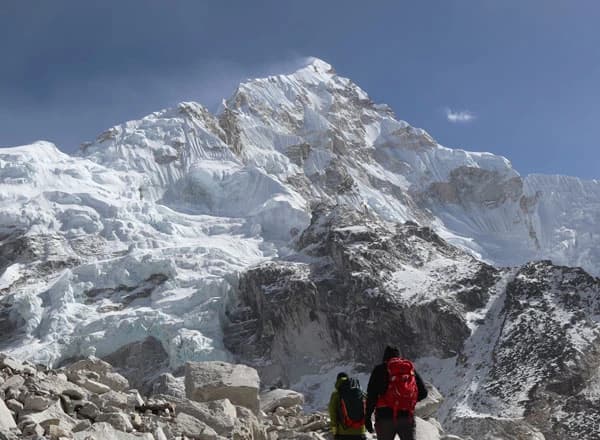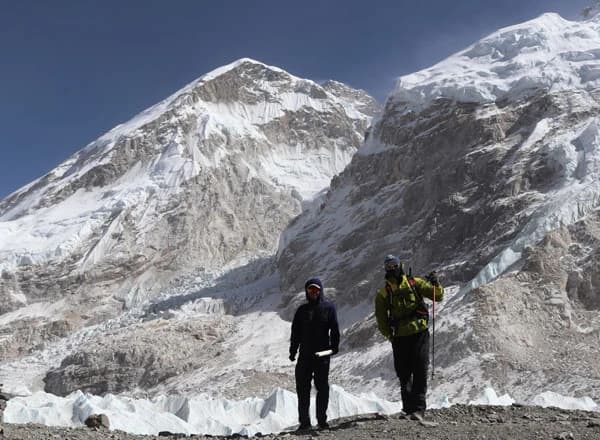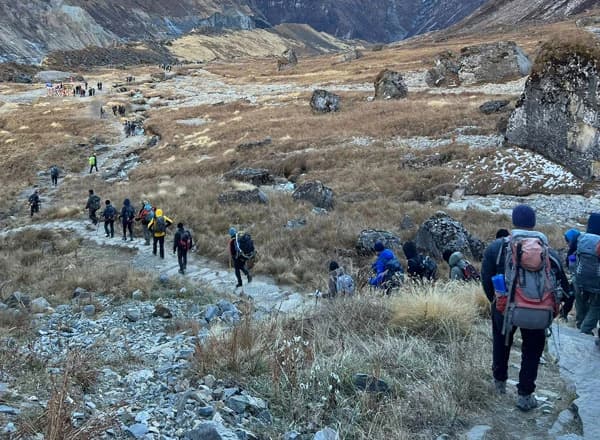Packing adequate equipment or gear when trekking to Everest Base Camp is important for a successful trek. If you are looking for a comprehensive guide to packing for the Everest Base Camp Trek, well, you are at the right place.
Everest Base Camp Trek Packing List
Everest Base Camp Trek Packing Guide
We have prepared this exceptional blog with everything you need to know regarding Everest Base Camp trek packing. We will discuss Everest Base Camp Trek clothes, gear, equipment, and a packing list.
Likewise, we have also shared information on luggage limits, extra luggage storage in Kathmandu, purchasing and renting trekking gear in Kathmandu, and packing tips. Before packing for the Everest Base Camp trek, trekkers should understand the unpredictable weather of the Himalayas and how the climate varies at different altitudes.
As you traverse the Everest Base Camp, you'll encounter various climatic zones and altitudes. From the lower hills to the temperate zone and then the sub-alpine, alpine, and polar zones, your clothing must be versatile enough to handle these changes. This variation in the landscape necessitates trekkers to be well-packed for various temperatures and weather conditions. Being well-equipped will give you a sense of security and confidence during the trek.
There is also an unpredictability factor associated with Everest Base Camp weather, which demands trekkers to be well-equipped for all kinds of weather changes. Some seasons demand extra warm or breathable pieces than others, but overall, you must be ready for all sorts of temperatures.
How are the weather and climate on the Everest Base Camp trek
Before you pack for the Everest Base Camp trek, you should know how cold it gets there and what climates and weather conditions you will encounter.
Because of the high altitude, the climate remains cold throughout the year along the Everest Base Camp trail. However, the temperature and weather conditions vary throughout the seasons.
If you are trekking in spring (March to May) and autumn (September to November), which the best is trekking period, you do not have to deal with extreme cold. Daytime is bright and sunny, with cold mornings and evenings. Overall, the climate is neither too hot nor too cold. However, if you trek in winter (December to February), note that it is the coldest time of the year.
Snowfall and snowstorms are frequent, and temperatures drop below -17°C. Meanwhile, in the summer/monsoon season (June to August), the weather fluctuates a lot, so you have to pack for all kinds of climate conditions.
The climate gets quite cold in summer/monsoon because of frequent rainfall. You will start walking from Lukla, situated 2,860 meters above sea level. From here, you will traverse different climatic zones and hike to Everest Base Camp, located at 5,364 meters above sea level.
The changes in environment, vegetation, climate, and landscapes from Lukla to EBC are drastic. Therefore, you must wear appropriate clothes to be comfortable throughout the journey. You can read the details of the Everest Base Camp Trek weather and temperature.
Everest Base Camp trek luggage weight per trekker
During the Everest Base Camp trek, every trekker must bring 15 kg, divided into 4-5 kg for a day pack and 10-11 kilograms of a duffel bag. Trekkers carry daypacks by themselves, which they can pack with essentials like water bottles, snacks, power banks, documents, cash, lip balm, sunscreen, etc. Porters carry the duffel bags.
Pack your trekking clothes, gear, and other stuff in a duffel bag or rucksack. We do not open duffel bags while trekking because of the hassle of loading and unloading on the porter. Usually, the porter walks ahead of us and reaches the lodge earlier than the rest of the group. So, you will only have access to your duffel bag in the lodge.
On the Lukla flight, trekkers can bring up to 10-11 kg of checked-in luggage and 4-5 kg of hand luggage. Even though the EBC trek requires limited luggage, you can bring clothes for other occasions while traveling in Nepal.
You can store your extra/unwanted luggage free of cost in your hotel's locker room or at our office during the trek.
*Note: You can pay the airline and the porter extra money for excess baggage.
Everest Base Camp Trekking clothes to Pack
For your better understanding, we have divided the different layers of clothing that you need for Everest Base Camp Trek and explained them below. Each layer is important to make the journey comfortable. The first thing you should know is that layering is the key.
You have to wear the clothes in three layers- the base layer (breathable and sweat-free), the middle layer (insulation), and the outer layer (the shell).
We have talked more in-depth about all three layers below.
Base layer
The base layer is closest to your skin, so it must be breathable and sweat-proof. We call it underwear. Buy underwear that draws moisture away from your skin using a synthetic material that doesn't absorb wetness.
Insulating layer
The second layer is the insulating layer. You will wear thermal clothes and fleece. These are the softest clothes and keep you warm and extremely comfortable during trekking. You should remove this layer while walking in spring and autumn. However, it is nice to wear it in the lodge at night.
The shell
It is the outermost layer of clothing. Waterproof jackets and pants are known as shells. This layer will protect you from sudden wind or rain during trekking.
The jackets have hoods, which are also good for keeping your head warm and cozy. Because of sunny days, trekkers usually wear a base layer and outer layer between March and May and September and November.
But that doesn't mean you don't have to pack insulating layers. You may not feel like wearing them all the time.
Trekking pants for Everest Base Camp Trek
Let's talk a bit about trekking pants. Wear a thermal pair inside and top it off with these waterproof/windproof pants on EBC Trek.
For ladies, stretchy workout tights will be ideal, and you can wear waterproof/windproof pants. It depends on the time of year you are trekking. Wear trekking pants as the weather demands.
Knockoff Everest Base Camp trekking gear in Kathmandu
In Thamel (the tourist hub in Kathmandu), you will find numerous shops selling good-looking knockoff EBC trekking clothes and gear from well-known brands. It doesn't matter whether your trekking clothes and gear are original. They have to do their job to keep you comfortable and cozy.
Note: If you are trekking in the winter season, your clothes have to be high-quality to keep you warm and comfortable. You do not necessarily have to buy expensive branded clothes, but high-quality insulation and the outer layer are required. Check your jackets are filled with synthetic material or goose/duck down. Jackets filled with goose/duck down are lighter and warmer than those filled with synthetic material.
Best backpacks for Everest Base Camp trek
A comfortable, good-quality, practical backpack is important for the Everest Base Camp trek. We recommend that trekkers be smart while choosing their backpacks for Everest Base Camp Trek.
You should use a dedicated backpack or daypack made for high-altitude treks like Everest Base Camp. However, you do not have to spend hundreds of dollars to get a decent daypack for the journey.
In Kathmandu, you will find excellent daypack options starting from USD 50 and above. If you are a seasoned traveler or trekker, we recommend investing in a high-quality daypack, as you will be using it for years.
Trekkers on a tight budget or who do not need to purchase a daypack can rent a nice one in Kathmandu for as little as USD 2 to USD 3 per day. Your daypack should be light, comfortable, and breathable. We recommend a daypack with size zippers, an adjustable torso, a rain cover, and various straps, clips, and zips.
It should fit well, so remember to try it on while shopping. A 35 to 50 L sized daypack is is for the Everest Base Camp trek and A 60 to 70 L Bag pack or duffle is recommended for EBC Trek.
Everest Base Camp Trekking boots recommendation
You must wear used sturdy trekking boots during the Everest Base Camp trek. They should be comfortable and support your ankle strongly while walking on rugged Himalayan terrain. Your trekking boots also have to be lightweight.
You will also need to carry hiking shoes or a casual pair of footwear like Crocs to wear in the lodge or when you are not trekking. You can buy brand new trekking boots for your trip, but do not bring a new pair on the trip. Break into your shoes and get used to them. Otherwise, you may get new shoes, blisters, and nuances, which will make the trek more challenging and painful.
On the Everest Base Camp trek, you will walk 6-7 hours daily in different climatic zones and altitudes. The trail is rocky, steep, and uneven, so ensure your trekking boots fit the conditions.
You can bring trekking shoes from home or buy them in Kathmandu. Renting is also very low-cost. Get boots that perfectly fit you and have room for your socks.
It's not recommended, but if you bring new trekking boots and get a blister or feel uncomfortable walking, make sure to take care of the situation before the issue gets bigger.
If you book the trek last minute and do not have time to break into your trekking boots, follow the below steps:
- First, insert a plastic bag into your shoes
- Fill it with water
- Freeze the boots with water in it
- Remove the plastic bag, and your shoes are ready to wear
- If you have time, repeat the process a few times
Tips:
- Wear a lightweight sock liner and heavier socks on top of that to reduce friction.
- Use duct tape to cover the area that has the potential to blister.
- Pack enough socks to change every day. It will keep you fresh after a long day of walking.
Sleeping bag for Everest Base Camp Trek
Everest Base Camp trail has ample lodges that provide the trekkers with cozy and comfortable sleeping spaces. You will get a warm blanket in the lodges, but it might not be enough, especially if you are sensitive to cold. So, a good-quality sleeping bag is essential to trek Everest Base Camp. You can purchase one at home or in Kathmandu. Likewise, you can rent high-quality sleeping bags at a very low rate. You will need a sleeping bag rated for -18°C.
Everest Base Camp trekking gear for different seasons
Generally, the base trekking gear and clothes are the same in all four seasons. Though packing for the Everest Base Camp trek can get intimidating, only a few additional items are required according to the weather.
However, if you follow our guidelines, you will not have a hard time, as we have mentioned even the tiniest details. Spring and autumn are the peak trekking times. The majority of trekkers visit the Everest Base Camp in these two seasons. These two seasons have mild climates, so you do not need to pack many warm pieces.
However, if you plan your EBC trek in the summer/monsoon or winter, you will need appropriate clothes and a few additional gears. For instance, rain gear is necessary for the summer/monsoon season. The winter season demands clothes that warm you at -18°C and below.
Below, we have shared packing lists for the Everest Base Camp trek in different seasons.
Everest Base Camp Trek packing for spring and autumn (September to November and March to May)
- Head and hand: Sun cap, wool/fleece hat, balaclava, neck gaiter/scarf, lightweight synthetic liner glove, wind Stopper fleece gloves/snow gloves
- Upper body: Short-sleeved shirts/t-shirts, synthetic or fleece Jacket, down insulated jacket, waterproof/windproof jacket
- Lower body: Underwear, trekking pants, synthetic insulated pants, windproof/waterproof pants, trekking socks
- First aid kit: Bandage, crack bandage, tincture, Lodine, Strepsils, antibiotic, paracetamol, aspirin, Sinex, anti-diarrhea capsule/Eldoper, Brufen/ibuprofens, Diamox, eye drops, zip-lock bags
- Toiletries: Hand sanitizers, hand wash/soap, wet tissues, toothpaste, toothbrush, bath soap, shampoo, moisturizers, laundry soap, SPF, lip balm, deodorant, toilet paper
- Miscellaneous: Torch, sandals, lightweight trekking boots, daypack, duffel bag, reusable water bottle, thermos/flask, pack towel, raincoat, spare batteries, solar chargeable power bank (optional), journal/pen, book/board game, bars & snacks
- Travel documents: Valid passport (six months of validity), Nepal travel visa, PP size photo, travel insurance paper (medical & rescue), family/company contact number and address, cash, credit card
Everest Base Camp Trek packing for summer and monsoon (June to August)
In summer and monsoon, you must pack ample rain gear to keep yourself and your bags dry. Due to frequent rain, the temperature may drop, making the climate cold. So, make sure you have high-quality thermal insulation. Also, pack insect repellent, wet/dry tissues, and other small essentials.
- Head and hand: Sun cap, wool/fleece hat, balaclava, neck gaiter/scarf, lightweight synthetic liner glove, wind Stopper fleece gloves/snow gloves
- Upper body: Short-sleeved shirts/t-shirts, synthetic or fleece Jacket, down insulated jacket, waterproof/windproof jacket
- Lower body: Underwear, trekking pants, synthetic insulated pants, windproof/waterproof pants, trekking socks
- First aid kit: Water purification tablets, bandage, crack bandage, tincture, Lodine, Strepsils, antibiotic, paracetamol, aspirin, Sinex, anti-diarrhea capsule/Eldoper, Brufen/ibuprofens, Diamox, eye drops, zip-lock bags
- Toiletries: Hand sanitizers, hand wash/soap, wet tissues, toothpaste, toothbrush, bath soap, shampoo, moisturizers, laundry soap, SPF, lip balm, deodorant, toilet paper
- Miscellaneous: Swiss knife, torch, sandals, lightweight trekking boots, daypack, duffel bag, reusable water bottle, thermos/flask, pack towel, raincoat, spare batteries, solar chargeable power bank (optional), journal/pen, book/board game, bars & snacks
- Travel documents: Valid passport (six months of validity), Nepal travel visa, PP size photo, travel insurance paper (medical & rescue), family/company contact number and address, cash, credit card
Everest Base Camp Trek packing list for winter Season (December to February)
Winter is the coldest time of the year and demands warm clothes and windproof outer layers. In addition to the usual trekking clothes and gear, focus on packing a few high-quality warm pieces. Likewise, get an electric blanket that can be operated using the battery. Also, pack a hot water bag to hold at night while sleeping, warm earmuffs, gloves, snow goggles, warm water flasks, etc.
- Head and hand: Sun cap, wool/fleece hat, balaclava, neck gaiter/scarf, lightweight synthetic liner glove, wind Stopper fleece gloves/snow gloves
- Upper body: Short-sleeved shirts/t-shirts, synthetic or fleece Jacket, down insulated jacket, waterproof/windproof jacket
- Lower body: Underwear, trekking pants, synthetic insulated pants, windproof/waterproof pants, trekking and climbing socks
- First aid kit: Water purification tablets, bandage, crack bandage, tincture, Lodine, Strepsils, antibiotic, paracetamol, aspirin, Sinex, anti-diarrhea capsule/Eldoper, Brufen/ibuprofens, Diamox, eye drops, zip-lock bags
- Toiletries: Hand sanitizers, hand wash/soap, wet tissues, toothpaste, toothbrush, bath soap, shampoo, moisturizers, laundry soap, SPF, lip balm, deodorant, toilet paper
- Miscellaneous: Swiss knife, torch, sandals, lightweight trekking boots, daypack, duffel bag, reusable water bottle, thermos/flask, pack towel, raincoat, spare batteries, solar chargeable power bank (optional), journal/pen, book/board game, bars and snacks
- Travel documents: Valid passport (six months of validity), Nepal travel visa, PP size photo, travel insurance paper (medical & rescue), family/company contact number and address, cash, credit card
Renting or buying Everest Base Camp trekking gear in Kathmandu
Thamel is the tourist hub in Kathmandu. The area has everything you will need during your trip to Nepal, whether trekking, touring, climbing, or other sports activities. Shops sell original branded trekking clothes, boots, bags, and other gear. Likewise, you will also find many stores selling knockoffs of many known brands.
Similarly, Nepali brands specialize in trekking and climbing clothes and gear, which they have designed after their extensive experience in the mountains. We highly recommend checking multiple stores and hearing about the products before buying one. We also recommend giving Nepali brands a chance and try their meticulously designed pieces.
Exploring Thamel's numerous alleys and hundreds of shops, restaurants, and hotels can over stimulate you. Don't worry. Our team will connect you with the best shops to buy high-quality trekking clothes and gear at the best price.
We will also suggest the best places to rent the highest-quality, well-managed trekking-related stuff at a very reasonable price. We have kept this information exclusive for our guests. If you want to know, feel free to contact us.
Laundry on the way to Mount Everest Base Camp
We do not recommend that trekkers rely on washing their clothes during trekking. First, you will not find a washing machine or dryer to wash and dry your clothes quickly.
Hand washing and air drying are necessary. Water in the Himalayas is always cold, and so is the air. Clothes dry in multiple days. In Namche, Dingboche, and Lukla villages, laundry service is available at an additional cost. However, it is better to carry ample clothes for the trip.
Carry ziplock bags to store used clothes and wash them after returning to Kathmandu.
Do you need crampons for Everest base camp trek
Generally, crampons are not required for the Everest Base Camp trek, the trek primarily involves walking on well-established trails, and good-quality hiking boots with sturdy soles are sufficient. However, exceptions depend on the time of year and weather conditions.
If you are trekking in the Winter months (December to February) and there is heavy snowfall, you may need crampons or traction devices.
If you are trekking in winter, lightweight alternatives like chained spikes or microspikes that fit over hiking boots can suffice for icy patches without requiring full crampons. Having high-quality waterproof hiking boots and trekking poles for stability is adequate for most trekkers. If unsure about the conditions, crampons can be rented or purchased in Kathmandu or Namche Bazaar.
Everest Base Camp trek packing tips
If you are trekking for the first time, packing for the Everest Base Camp trek can be time-consuming because you have to manage many small and significant essentials.
packing your stuff, print a packing checklist and tick-mark it after acquiring the gear. Also, note all the tips you have collected from different sources and print them out. Read them regularly during packing. Our many years of experience helping foreigners pack for the Everest Base Camp trek have allowed us to accumulate tips to make your packing smooth and hassle-free.
Pack your clothes so you can easily access them. Pack frequently needed pieces on top. You can pack the clothes in stuff sacks and label them.
- Carry zip-lock bags to store used clothes, trash, and toilet paper.
- Roll your sleeping bag liner inside the sleeping bag to save space.
- Carry insect repellent or a pot of tiger balm. In the lower elevations, it will protect you from insect bites.
- Get some lightweight travel games today. In the evening, you can play them in lodges with fellow trekkers. It will keep you entertained.
- Pack a flip-flop or Crocs for showers or walking around the lodge.
- You should keep flu and cold medicine in your first aid kit. At night, you should also carry a muscle pain reliever spray like Move.
- Carry a small repair kit with tape, spare shoelaces, a torch, a nail cutter, and a small knife.
- Pack travel deodorant and mints to keep yourself refreshed. You will be eating a lot of garlicky soups and food, so mint will keep your breath fresh.
Conclusion
I hope you enjoyed reading the above article about the Packing list for the Everest Base Camp Trek. Let us know if you need further information about Nepal's Everest Base Camp Trek. We also have share packing list for others treks in Nepal whihc are:
Is an Everest Base Camp Trek in February possible? Yes, it is, and it is enjoyable. Given this month's poor reputation for unstable weather and a cold climate, February sounds like a very odd time [...]
Start the New Year with a challenge of a lifetime that will shape you to become the most excellent version of yourself. Join us for the Everest Base Camp Trek in January and get guided [...]
It is undoubtedly possible to trek in Nepal during the winter season, which lasts from December to February. December starts the winter season, and February ends it. So, trekking in Nepal in December and February [...]
